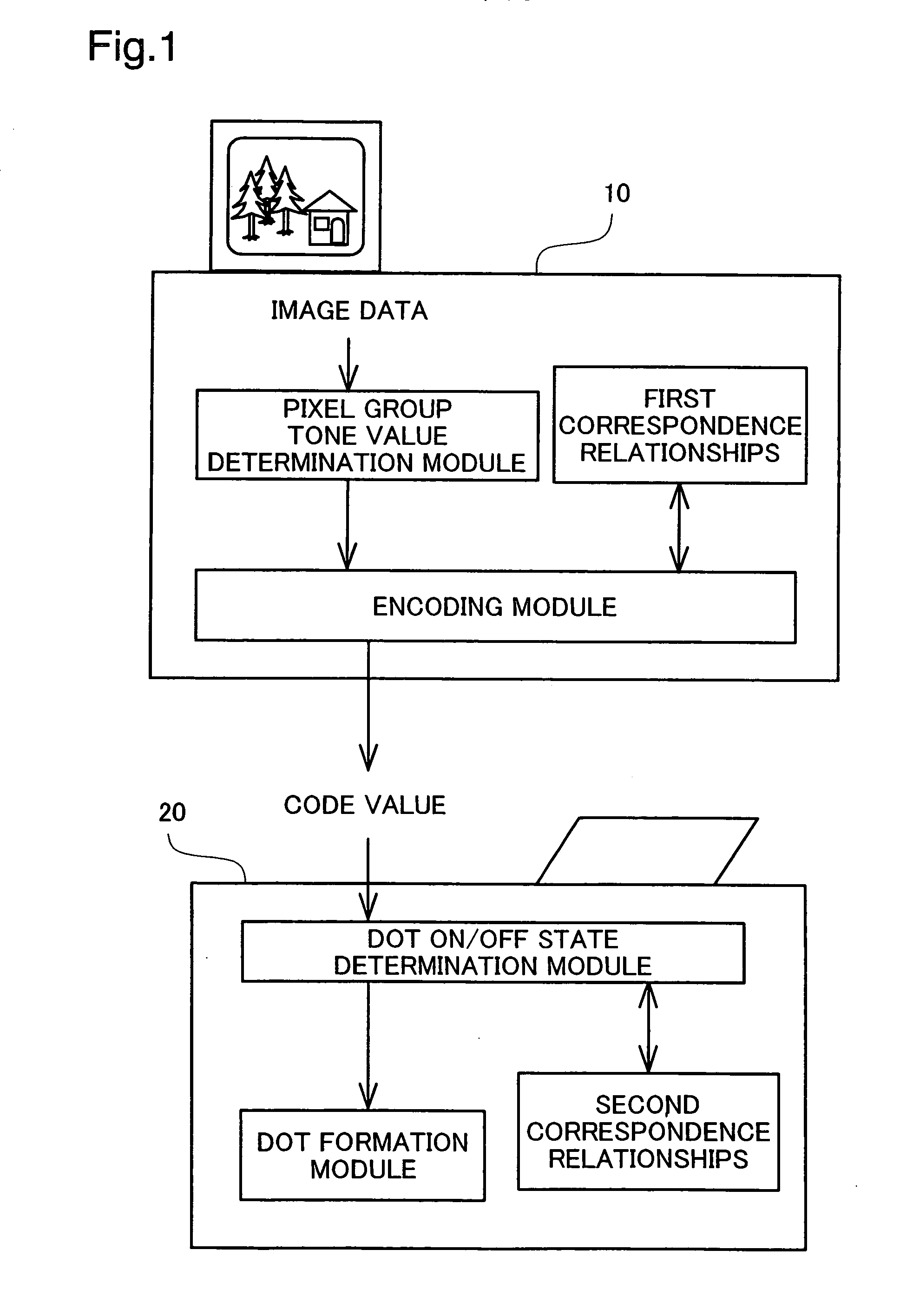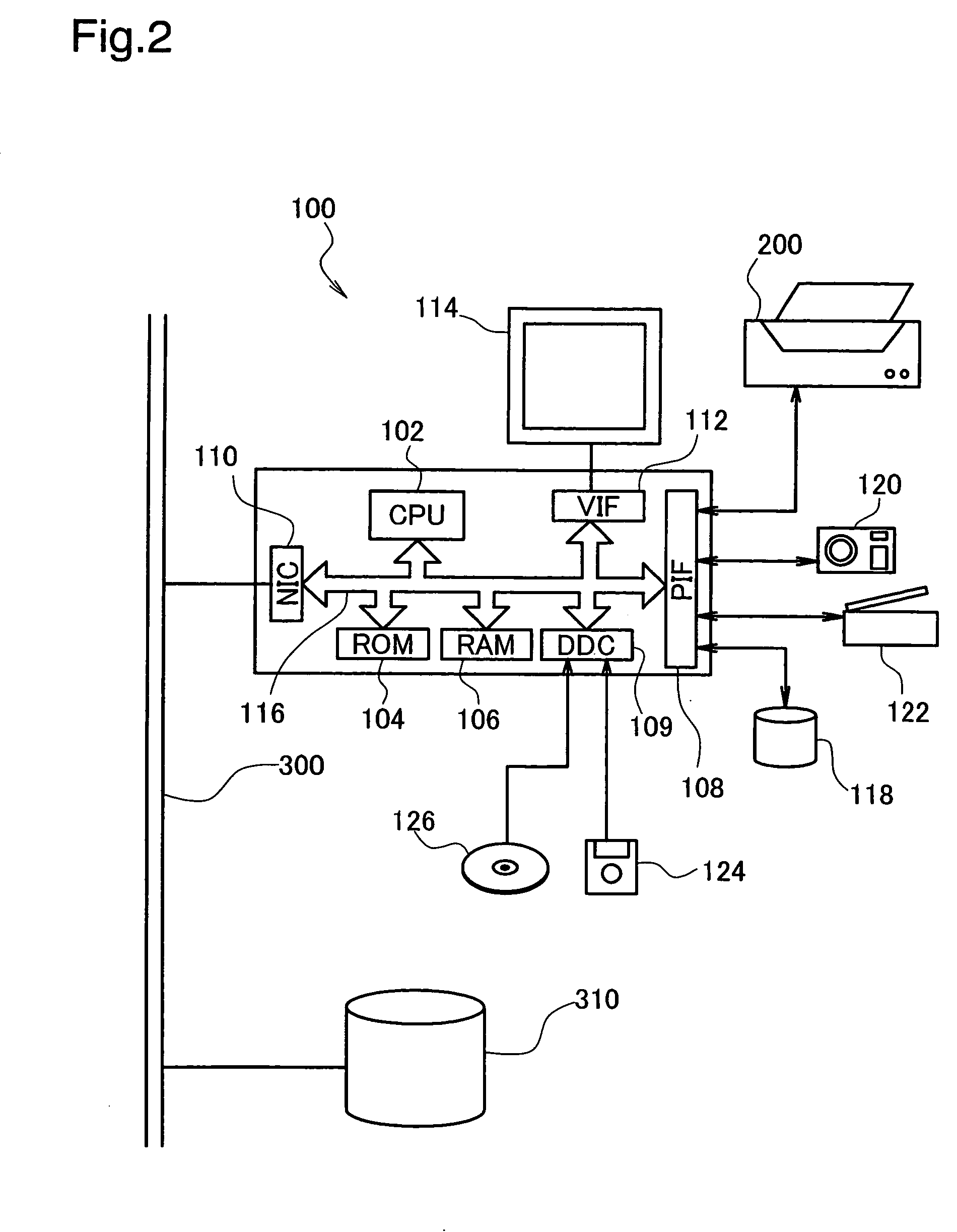Dot data processing apparatus, image processing system, and image data processing apparatus
a technology of image data and processing apparatus, applied in the field of processing images, can solve the problems of inability to carry out image processing using image processing apparatuses with high image processing capabilities, inability to quickly output images, and inability to achieve high-quality images, reduce storage amount to be equipped, and save tim
- Summary
- Abstract
- Description
- Claims
- Application Information
AI Technical Summary
Benefits of technology
Problems solved by technology
Method used
Image
Examples
embodiment 1
C. Overview of Image Printing Process of
[0133] C-1. Overview of Multi-value quantization Result Generation Process:
[0134] C-2. Overview of Dot On / Off State Determination Process:
[0135] C-3. Overview of Dither Method:
[0136] C-4. Conceptual Approach of Determining Classification Number:
[0137] C-5. Multi-value Quantization Table Setup Method:
[0138] C-6. Conversion Table Setup Method:
[0139] C-7. Order value matrix Setup Method:
[0140] C-8: Basic Principle Enabling Appropriate Determination of Dot On / Off State from Multi-value Quantization Result Values:
[0141] C-9. Method of Determining Classification Number from Pixel Group Location:
[0142] C-10. Variation Examples:
D. Embodiment 2:
[0143] D-1. Basic Principle of Dot On / Off State Determination Process of Embodiment 2:
[0144] D-2. Dot On / Off State Determination Process of Embodiment 2:
E. Embodiment 3:
[0145] E-1. Basic principle of improving picture quality:
[0146] E-2. Dot on-off state determination process of Embodiment 3:
[0...
embodiment 2
D. Embodiment 2
[0326] In the dot on / off state determination process of Embodiment 1 discussed previously, when per-pixel group multi-value quantization result values are received, by means of lookup in the conversion table shown in FIG. 12, they are initially converted to data representing dot counts, and subsequently pixel locations for forming dots within the pixel groups are determined with reference to the order value matrices. However, once per-pixel group multi-value quantization result values have been received, it would be possible to instead determine directly the pixel locations for forming dots within the pixel groups. The dot on / off state determination process of such an Embodiment 2 shall be described below.
D-1. Basic Principle of Dot On / Off State Determination Process of Embodiment 2:
[0327] As shown in FIG. 27, in the dot on / off state determination process of Embodiment 1, once a per-pixel group multi-value quantization result value has been received, the classifica...
embodiment 3
E.
[0337] In the output dot arrangement determination process of the embodiments discussed previously, when determining dot on-off states for pixels from multi-value quantization result values derived on an individual pixel group basis, the dot on-off states were determined using a method based on a dither matrix. Specifically, focusing on the fact that threshold values established in a dither matrix can be viewed as representing the ease of forming a dot, in Embodiment 1, the dot on-off states for pixels were determined on an individual pixel group basis, using a order value matrix established on the basis of a dither matrix. In Embodiment 2, dot data established on the basis of a dither matrix was established in a conversion table, and the dot on-off states for pixels were determined on an individual pixel group basis from the multi-value quantization result values, by means of lookup in the conversion table. Thus, the distributions of dots obtained by means of the dot on-off state...
PUM
 Login to View More
Login to View More Abstract
Description
Claims
Application Information
 Login to View More
Login to View More - R&D
- Intellectual Property
- Life Sciences
- Materials
- Tech Scout
- Unparalleled Data Quality
- Higher Quality Content
- 60% Fewer Hallucinations
Browse by: Latest US Patents, China's latest patents, Technical Efficacy Thesaurus, Application Domain, Technology Topic, Popular Technical Reports.
© 2025 PatSnap. All rights reserved.Legal|Privacy policy|Modern Slavery Act Transparency Statement|Sitemap|About US| Contact US: help@patsnap.com



